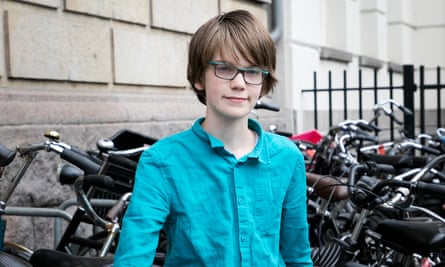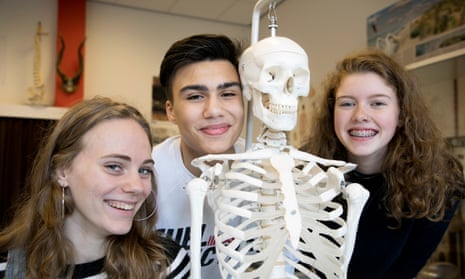In a biology class at a secondary school near Rotterdam, Gerrit the skeleton is not the only one with a permanent grin.
The Groen van Prinstererlyceum, which first trialled happiness lessons a decade ago, teaches some of the least troubled teens in the world.
In report after report, the Netherlands tops OECD countries for high life satisfaction among its young people. It contrasts starkly with the picture in countries like Britain, where depression and anxiety are on the rise among teenagers, and the US, where the number of young people taking their own lives has risen sharply.
So why is this flat, damp country of 17 million people with its history of Calvinism and colonialism so good at giving young people an optimistic outlook?
Dr Simone de Roos, a researcher at the Netherlands Institute for Social Research (SCP), says life satisfaction among teenagers has not dropped since 2013.
“I think Dutch children have generally positive interactions in all their social surroundings,” says De Roos. “They have a supportive environment at home, with friends and also at school. Dutch parents give a lot of support and have mild control. There’s an egalitarian climate, teachers are not authoritarian but accept the feelings of pupils, and pupils trust teachers.”
The last Health Behaviour in School-aged Children (HBSC) study, comparing children of 11, 13 and 15, showed a happy Dutch youth. When asked where they would be on “Cantril’s ladder” – with the worst possible life for them on 0 and their best at 10, about 94% of Dutch boys said six or above. Dutch girls were slightly lower, ranging from 84% to 92%.
Quick GuideWhat is the Upside?
Show
Ever wondered why you feel so gloomy about the world - even at a time when humanity has never been this healthy and prosperous? Could it be because news is almost always grim, focusing on confrontation, disaster, antagonism and blame?
This series is an antidote, an attempt to show that there is plenty of hope, as our journalists scour the planet looking for pioneers, trailblazers, best practice, unsung heroes, ideas that work, ideas that might and innovations whose time might have come.
Readers can recommend other projects, people and progress that we should report on by contacting us at theupside@theguardian.com
According to that report, young people in the Netherlands were also in the top five for eating breakfast on weekdays, watching more than two hours of weekday television, having kind and helpful classmates – and in the bottom five for being overweight, having sex before 15, and feeling pressure from schoolwork. They were less likely than average to experience bullying and generally found it easy to talk to parents.
The results chime with a 2016 Dutch Statistics Office study of 4,000 people from 12 to 25, who ranked their happiness at 8.4 out of 10, and a PISA report in 2015 noting that the country – alongside Finland and Switzerland – seemed “able to combine good learning outcomes with highly satisfied students”.
Of course, the general state of the nation helps. There is little unemployment in the Netherlands, relatively low inequality and a healthy economy. Five months ago the SCP compared the Netherlands favourably with 25 years ago, while another study showed people were more optimistic than last year. “At some point there’s a critical mass of optimistic voices, and then it gets its own dynamic,” says Prof Paul Dekker, the SCP programme leader in values and meaning.
The director of the World Database of Happiness, Prof Ruut Veenhoven, also believes young people are less burdened by an expectation to “be good”.
“If you look across Europe, the Dutch and the Danes are the most lenient and focus more on developing autonomy than giving priority to obedience – and that fits the society,” he says. “Children are more free to do what they want, and in doing what they want, develop an idea of what they really like and social skills. A happy boy may be sometimes not a very good boy.”
In Dutch, there is no phrase that means literally “you are a good boy” or “good girl”, says 14-year-old Tjalling Appelhof, from Amsterdam. “You say ‘bravo, lad’ or ‘well done’ or ‘thank you’,” he says. Like most Dutch teenagers, he cycles to school and feels he has a good level of self-determination. “I can say how late I come home – not at 3am, I mean, but some time before bedtime!” he says. “I think I have enough freedom.”

Despite the country’s reputation for cannabis smoking, the Trimbos Institute reports a downward trend for using alcohol and drugs and smoking in Dutch children aged 12 to 16. Such activities are described by HBSC experts as “risk behaviours” that impact happiness.
Other negatives are bullying and fighting. At Groen van Prinstererlyceum, Dani Karremans, a 16-year-old majoring in sciences, believes such pressures are not extreme in the Netherlands.
“If I compare things with other countries and especially other schools, you hear that people are bullied, often seriously,” he says. “Here, you don’t really see that. If people try to bully me, I just ignore it. I’ve got my own friends who I get on with. I don’t have a social ‘image’ or think that everyone has to like me – it’s not realistic.”
Dani, whose mother is Indonesian and Polish and whose father is Moroccan, says his father spends more time on Facebook than he does.
Saffron Jones, also 16, and majoring in social sciences, is half-English and half-Dutch. She says that from when her parents split up 11 years ago, her friendship group has always been supportive. “I could always stay with my friends at primary school. Now, if I’m stressed about school, mostly one of my friends is good in that subject, so I’ll call them and they help. It calms me down.”

The HBSC data supports this: 86% of Dutch teenagers say their classmates are kind and helpful, putting the country top of the tables at 13 and 15. Sex education starts at four, and Saffron says her boyfriend is accepted by her friends and parents. Meanwhile a poster on her school’s wall encouraging people of all sexualities to “come out” reaffirms that openness is OK. The rate of teenage pregnancies in the Netherlands is also the lowest in the EU.
The Dutch school system – almost entirely publicly funded – incorporates major exams at about the age of 12 and three levels of secondary education from practical to the most academic. But it is possible to progress from one to the other or repeat a year and, despite concerns about dropping standards and increasing segregation, such flexibility could make for less stress.
Yara Agterhof, 17, from Vlaardingen, has just changed her subject focus. “I was a year ahead, [taking] physics, chemistry and biology,” she says. “I figured it was too hard for me and made a decision to go back. Now I have a different profile with the things I do actually enjoy. I don’t feel like I’ve lost a year and I think my parents feel: ‘As long as you’re happy, we’re happy.’”
There are social problems such as differences between minority ethnic and native Dutch achievement, while one in nine children grows up in poverty. But Jacqueline Boerefijn, a biology teacher at the Groen van Prinstererlyceum, says even if a school wants to expel a child, it must find another school for them, so there are incentives to deal with issues.

But Boerefijn, who developed happiness classes at the school a decade ago, and also gives positive psychology lessons to educators, is worried that Dutch children are under threat from new pressures around educational achievement.
“Please stop putting the bar higher, because we have happy children,” she says. “We already have so many highly educated people, and at the moment there are not enough people to do the plumbing and carpentry jobs.”
For Tjalling, it is pretty simple. “In the Netherlands we are rich, most things around children are well organised, like school and healthcare, and if people are poor, we try to help them. That’s maybe why children are happy.
“It rains a lot. But you get used to it.”
- This article is part of a series on possible solutions to some of the world’s most stubborn problems. What else should we cover? Email us at theupside@theguardian.com
